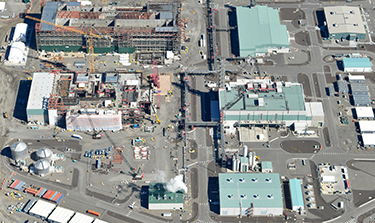About the Hanford Vit Plant Project
 In southeastern Washington state, Bechtel National, Inc. is designing, constructing, and commissioning the world’s largest radioactive waste treatment plant for the U.S. Department of Energy (DOE). When complete, the Hanford Tank Waste Treatment and Immobilization Plant, also known as the Vit Plant, will process millions of gallons of radioactive and chemical waste. The waste, the byproduct of plutonium-production efforts during World War II and the Cold War, are currently stored at the Hanford Site, just miles from the vast Columbia River.
In southeastern Washington state, Bechtel National, Inc. is designing, constructing, and commissioning the world’s largest radioactive waste treatment plant for the U.S. Department of Energy (DOE). When complete, the Hanford Tank Waste Treatment and Immobilization Plant, also known as the Vit Plant, will process millions of gallons of radioactive and chemical waste. The waste, the byproduct of plutonium-production efforts during World War II and the Cold War, are currently stored at the Hanford Site, just miles from the vast Columbia River.
After years of commitment to the safety and quality of the Vit Plant, Bechtel National, Inc. its partners, and DOE are completing the final steps toward operations of Direct-Feed Low-Activity Waste (DFLAW). By starting to process Hanford’s low-activity waste, the majority of the waste on the Hanford Site, we are securing a cleaner, safer future.
 Reducing Risk of Legacy Waste
Reducing Risk of Legacy Waste
During World War II and the Cold War, the Hanford Site was used to produce plutonium that was critical to national defense efforts. As a result, the 56 million gallons of radioactive and chemical waste now reside in 177 aging underground tanks. Of these, more than 60 have leaked, contaminating the subsurface and threatening the nearby Columbia River and surrounding communities. For more on Hanford’s history, see the DOE Hanford Site website.
The Vit Plant is one of DOE’s most technically challenging environmental clean-up projects because it is largest plant of its kind and because Hanford’s waste is so unique:
- Hanford’s tanks contain the most complex heterogeneous radioactive waste at any U.S. clean-up site.
- The waste is in the form of sludge, salts, and liquids.
- No two tanks have the same combination of waste.
- There are 1,800 different chemicals in the tank waste.
What is Vitrification?
 The Vit Plant will use proven vitrification technology to stabilize the radioactive waste. Vitrification involves mixing the waste with glass-forming materials, heating it to 2,100 degrees Fahrenheit, and pouring it into stainless steel containers to cool and solidify. In this glass form, the waste is stable and safe for permanent disposal.
The Vit Plant will use proven vitrification technology to stabilize the radioactive waste. Vitrification involves mixing the waste with glass-forming materials, heating it to 2,100 degrees Fahrenheit, and pouring it into stainless steel containers to cool and solidify. In this glass form, the waste is stable and safe for permanent disposal.
The vitrification process has been used successfully elsewhere for decades but has never been done at the scale of or on waste as complex as that stored at Hanford.
Near-term Approach
DOE is focusing on processing Hanford’s low-activity waste first as part of its DFLAW approach to enable the plant to begin operations as soon as practicable. Under DFLAW, pretreated waste will be sent directly from Hanford’s Tank Farms, where the waste is stored, to the Vit Plant’s Low-Activity Waste Facility for vitrification.
High-level waste will be processed and vitrified at a later date. Both engineering and construction work continue on the High-Level Waste Facility, as DOE and Bechtel National, Inc., remain committed to completing the mission.
For more information, see the DOE Hanford Site Vit Plant website.





